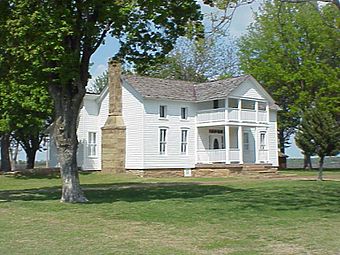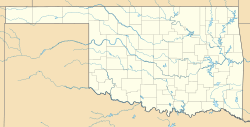Dog Iron Ranch facts for kids
Quick facts for kids |
|
|
Will Rogers Birthplace
|
|

The house at Dog Iron Ranch in which Will Rogers was born
|
|
| Location | Rogers County, Oklahoma, U.S. |
|---|---|
| Nearest city | 9501 E. 380 Rd., Oologah, Oklahoma |
| Area | 1,536 square feet (142.7 m2) |
| Built | 1875 |
| Architectural style | Greek Revival |
| NRHP reference No. | 70000538 |
| Added to NRHP | September 29, 1970 |
The Dog Iron Ranch is a special historic ranch located near Oologah, Oklahoma, in the United States. It's famous because it's the birthplace of a well-known American humorist named Will Rogers.
The Rogers family gave this ranch to the State of Oklahoma. Today, the Cherokee Nation owns and manages it. The ranch you can visit now is about 400 acres (1.6 km2) in size. This is a small part of the original ranch, which was huge, covering 60,000 acres (240 km2)! Will's father, Clem Rogers, ran the original ranch. He was a very important cattle rancher and a Cherokee leader. Back then, the ranch had as many as 10,000 Texas Longhorn cattle. Today, you can still see about 50 Longhorns there.
Contents
History of Dog Iron Ranch
The Birthplace House
Clem Rogers built the main house at Dog Iron Ranch in 1875. This was four years before his famous son, Will, was born. The house is built in a style called Greek Revival, which means it looks like old Greek temples with columns and grand entrances. Clem lived in this house until his wife passed away in 1890.
The first floor of the house was built using strong logs from local oak, hickory, and walnut trees. It measures 48 feet (15 m) long and 32 feet (9.8 m) wide, covering an area of 1,536 square feet (142.7 m2). Originally, the two front rooms were each 16 feet (4.9 m) square. They were separated by a "dog trot," which was an open hallway. Later, this dog trot was enclosed to create a foyer, or entrance hall.
The rooms downstairs were used as a parlor, which is like a living room, and a master bedroom. This bedroom also served as Clem Rogers' office. A smaller addition, called a lean-to, held the kitchen, dining room, and an extra bedroom. Upstairs, above the front rooms, there were two more bedrooms.
A Center of Influence
Clem Rogers was a very important person in local politics. Because of his influence, the house was not just a family home. It was also a place where important political decisions were made. People often called it "The White House on the Verdigris," named after the nearby Verdigris River.
The Ranch Barn
The barn you see at the ranch today was built on July 17, 1993. About two dozen Amish carpenters built it. They used traditional methods, like notch and peg construction, which was common in the 1800s. This means they fit wooden pieces together without using many nails.
For safety, the barn's roof is covered with asphalt shingles instead of wooden shakes, which are more likely to catch fire. The new barn is 48 feet (15 m) by 64 feet (20 m). The original barn and possibly two others after it were destroyed by wildfires. The current barn has traditional stalls for animals. It also includes a classroom area that can be used for eating.
Moving the House
In the 1960s, the house where Will Rogers was born was moved about a mile from its original spot. This was necessary because the nearby Lake Oologah reservoir was being built. The house was carefully moved to its current location on the ranch.
Ownership Changes
On March 7, 2016, Governor Mary Fallin signed a new law. This law placed the Will Rogers Memorial Commission under the control of the Oklahoma Historical Society. The Commission used to manage both the Will Rogers Memorial Museum and the Dog Iron Ranch.
More recently, on June 12, 2023, ownership of the Will Rogers Birthplace Ranch was officially transferred to the Cherokee Nation. The ranch is now open for visitors to explore and learn about Will Rogers' early life.
Will Rogers' California Ranch
Will Rogers also owned another property known as Will Rogers Ranch in Pacific Palisades, California. He bought this ranch in the early 1930s after he moved to California. After his passing, this property became the Will Rogers State Historic Park in 1944. It is now a California State Park that people can visit.
See also



